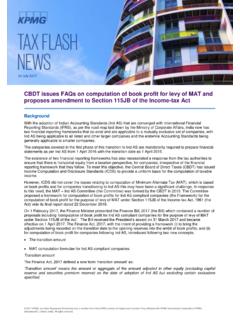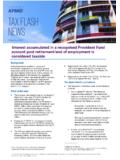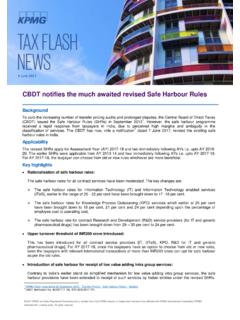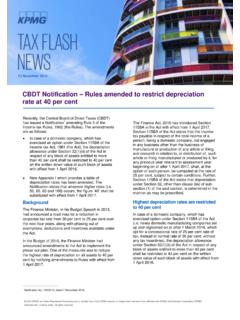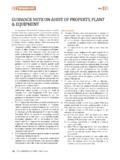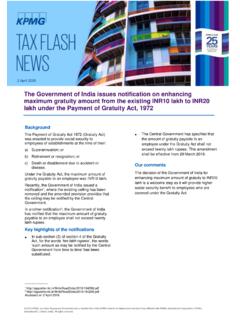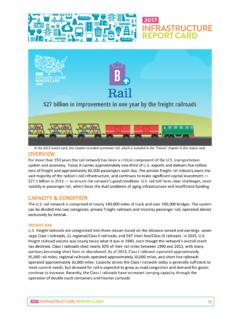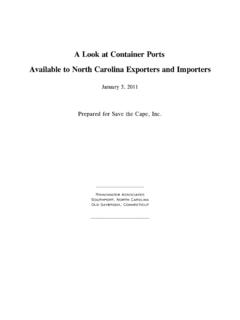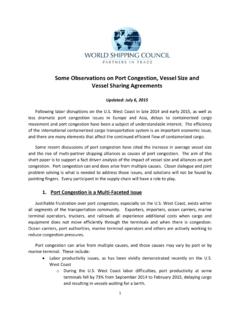Transcription of KPMG IN INDIA
1 kpmg IN INDIAI ndian Maritime Landscape- A Background noteFebruary 2008 INFRASTRUCTURE & GOVERNMENTKPMG is the global network of professional services firms of kpmg International. Our member firms provide audit, tax and advisory services through industry focused, talented professionals who deliver value for the benefit of their clients and communities. With nearly 123,000 people worldwide, kpmg member firms provide services in 148 member firms of kpmg International in INDIA were established in September 1993. As members of a cohesive business unit, they respond to a client service environment by leveraging the resources of a global network of firms, providing detailed knowledge of local laws, regulations, markets and competition. We provide services to over 2,000 international and national clients, in INDIA . kpmg has offices in INDIA in Mumbai, Delhi, Bangalore, Chennai, Hyderabad, Kolkata and Pune. The firms in INDIA have access to more than 2500 Indian and expatriate professionals, many of whom are internationally trained.
2 We strive to provide rapid, performance-based, industry-focused and technology-enabled services, which reflect a shared knowledge of global and local industries and our experience of the Indian business 's Infrastructure and Government (I&G) Line of Business (LoB) has undertaken a number of pioneering projects in sectors such as power, ports and shipping, airports, roads, rail, shipbuilding, oil and gas, amongst others. kpmg 's I&G LoB has undertaken projects in areas such as business planning, policy formulation, capacity planning, competitor analysis, traffic assessment, strategy development and business continuity the ports and shipping sector, kpmg and its network of member firms have been involved in business planning, policy formulation, IT infrastructure assessment, traffic projections, competitor analysis, demand planning for ports in INDIA and abroad. In addition to this, kpmg and its network of member firms have been involved in the business planning exercise for Jawaharlal Nehru, Mumbai and Kandla Port Trusts.
3 kpmg and its member firms have assisted emerging minor ports and potential developers on regulatory and concession issues, provided bid advisory and assisted in the formulation of strategic development know more about kpmg 's Infrastructure and Government LoB, you can contact:Arvind Mahajan,National Industry DirectorInfrastructure and Government Tel: + 91 22 3983 6206 Fax: + 91 22 3983 6000e-Mail: kpmg in INDIA (Knowledge Partner) INDIA 's international trade is expected to expand at a fast pace given the growth projections of the Indian economy. Since, more than 90 percent of INDIA 's trade by volume is seaborne there is a need to review whether the Indian Maritime Industry as well as related inland transport and logistics industry is in a position to handle the expected key challenges for the port sector are to remove capacity constraints (physical infrastructure) as well as to enhance operational efficiency and sector-specific human resource pool (soft or enabling infrastructure).
4 However, herein lies the opportunity as well. In the next 5 years USD 18 billion will need to be invested in the ports sector and nearly 74 percent of this will need to be invested by the private sector. In this context, the port sector is poised to launch many projects given that the business plans of all the Major Ports have been drawn up. Several state governments are also taking initiatives to develop minor ports along their coast lines. Thus, there are significant opportunities for the private sector at both major and minor ports in port and terminal development and operation, land access infrastructure (CFS/port warehousing, tank farms, etc.) maritime construction projects and dredging, and port support services (piloting, stevedoring, bunkering,etc).The Indian shipping industry faces challenges on account of higher tax regime and operational factors (ageing fleet, human resource shortages, etc) but the outlook remains bright. The ability of the Indian shipping industry to capture potential value will depend on regulatory support and creation of a supporting 'ecosystem' ( chartering, financing, ship design, etc.)
5 The same holds true for the shipbuilding and repair industry, which is at a nascent stage but has potential to capture an increasing share of the global market with the right fiscal and regulatory is equally important to establish good inter-modal connectivity within the country. This will enable cargo to move through the most efficient transport modes and reduce logistics costs. Besides road and rail connectivity, special attention can be paid to coastal shipping and inland waterways with lessons drawn from international kpmg whitepaper on Indian Maritime Landscape reviews the current scenario in the Maritime sector and identifies the areas to be addressed. I hope you find the report MahajanExecutive Director, Advisory and National Industry Director (Energy, Infrastructure and Government)KPMGF orewordIntroduction01 Global Maritime Outlook03 Indian Maritime Sector Outlook09 Conclusion32 List of Abbreviations33 Global Shipping TrendsGlobal Maritime Security Environment07 OverviewPortsShipbuilding and Ship Repair Industry17 Shipping Industry20 Dredging23 Inter Modal Connectivity25 Human Resource Development30 ContentsIndia's trade sector is witnessing a long term and sustainable high growth trend driven by the rapid growth of the Indian GDP.
6 International and domestic trade volumes are expanding rapidly and its impact is evident in the burgeoning traffic volumes of the shipping and ports sector, over the past few years. This growth trend is expected to continue over the medium term with INDIA continuing to attract global capital inflows into manufacturing and infrastructure sectors and trade tie-ups with , EU and China and South East Asian and South Asian trade blocs get cemented further. This high growth in trade would, in turn, translate into additional demand pressures on the Indian shipping and ports port sector in INDIA has witnessed significant growth in the recent past, especially in the container terminal segment. Over 95 percent of INDIA 's international trade by volume takes place through ports, and hence, ports play an important role in INDIA 's Export Import (EXIM) trade. Recent Government initiatives in the sector have led to domestic and international players investing in Indian ports. Current growth trends suggest that the Indian port sector would require a significant increase in capacity to meet future cargo demand.
7 Accordingly, Indian ports have developed capacity expansion plans. Many major ports in INDIA have adopted the Build Operate Transfer (BOT) model to facilitate the development of additional capacity. This has resulted in the entry of international players such as DP World, Maersk, PSA, etc. in the Indian ports sector. On the other hand, private sector investments in minor ports have also increased with successful participation in ports like Mundra, Pipavav, Hazira, Gangavaram, Krishnapatnam, Dhamra, Gopalpur, etc. Leading private ports like Mundra and Pipavav have also developed ambitious expansion plans. However, the sector faces constraints on account of hinterland connectivity, inland cargo handling infrastructure, and shortage of skilled manpower for port operations (including marine services, amongst others). It is important that these constraints are addressed to enable unhindered growth of INDIA 's port TransportationShipping is a cyclical business and is affected by ship-manufacturing activity around the world.
8 When demand for tonnage increases, new ships are ordered. Following the current surge in demand, order books for new ships are at an all time high. Other interesting trends in the sector include increasing ship sizes, the integration of shipping lines and port operators, efforts towards horizontal integration/alliances, etc. These trends have increased the bargaining power of shipping lines vis- -vis other players in the value chain. The Indian shipping industry has also been increasing capacity. Many players have developed expansion strategies and are raising capital through the market to finance the same. As global competition increases, the Indian shipping industry will have to expand and upgrade its fleet to improve its efficiency and become activity will witness significant expansion driven by growth of greenfield ports and expansions of Major ports. Government of INDIA plans to open dredging contracts for participation by private sector and future projects are likely to be awarded on open competitive bidding.
9 This creates significant opportunities for dredging operators. This creates significant opportunity for Indian and International dredging companiesGrowth in multi modal transport arrangements is crucial for reducing the logistics cost of Indian trade, which currently is significantly above global average, and is a key competitiveness pre-requisite to support future growth of trade and cargo traffic, thus having a direct bearing on ports and shipping sector. INDIA would need to focus on multi-modal transport to facilitate the movement of goods from inland locations to ports and vice-versa. At varying distances, the various modes of transport, , road, rail and coastal shipping, provide different relative advantages in terms of economy and accessibility. This would require development of road and rail infrastructure, improvement in multi-modal transport, and modifications in procedural arrangements to allow smooth flow of traffic (load limits on road, etc.).Overall, the Indian maritime sector is poised for healthy growth in line with the growth of the Indian economy.
10 This requires planning and investments by all stakeholders, including the Government and the public and private sector, for developing the requisite infrastructure, improving current processes and introducing policy measures that create a conducive environment for players in the Shipping TrendsLarger Vessel SizesOver the years, vessel sizes in maritime trade have increased as a consequence of the need to reduce operating costs by achieving economies of scale. The economies of scale operate as new building prices per Dead Weight Tonne (DWT) are far lower for larger ships. For example, in 2006-07 at USD 433, the price per DWT on a 300,000 DWT tanker was only 41 percent of the price on a 45,000 DWT tanker. In the case of dry bulk carriers, the price per DWT on a 170,000 DWT vessel was USD 412, which represents 60 percent of the price per DWT on a 45,000 DWT dry bulk segment, the average size of ships on order has increased from 64,000 DWT in December 2000 to 80,000 DWT in December , the container ship fleet has witnessed a rise in average size.
